Description and Identification
Graptemys pseudogeographica pseudogeographica is a medium to large map turtle. Females will typically reach 8-10”(20.3-25.4cm), max 10.6” (27cm), while males stay smaller at 3.5-5.5” (8.9-14cm), max 5.9” (15cm). The carapace is olive to brown with yellow, oval-shaped markings and a dark blotch on each pleural scute. It has a defined, but low keel and its posterior edge is serrated. Small vertebral spines are noticeable in hatchlings and juveniles, but almost completely disappear in adult females. The plastron is cream to yellow with an extensive seam following pattern that slowly vanishes with age. The skin of the head, neck, legs, and tail is olive to dark olive with yellow markings. The post-orbital mark is typically hockey-stick- or L-shaped with the handle extending as a stripe down the neck, though it is variable and occasionally appears as a triangular or rectangular blotch. There are typically dots above and below the jaw-line on each side of the head. The post-orbital mark mentioned previously and combined with yellow eyes with a transverse bar and a yellow beak identifies G. p. pseudogeographica from the other subspecies, G. p. kohnii. Males will have longer and wider tails with the cloacal opening 1/2 to 2/3rds of the way down the tail and a more juvenile appearance. Females will have shorter, narrower tails, a much larger build, and broader heads, though not to the extent of the broad-head group of Graptemys species.
-
 Primary ID: Hockey-stick-shaped post-orbital markingsPrimary ID: Hockey-stick-shaped post-orbital markings
Primary ID: Hockey-stick-shaped post-orbital markingsPrimary ID: Hockey-stick-shaped post-orbital markings -
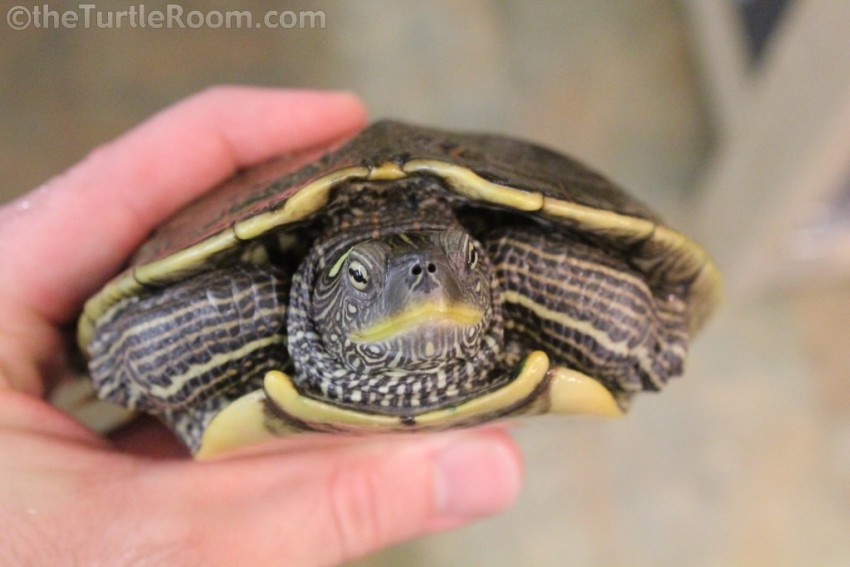
-
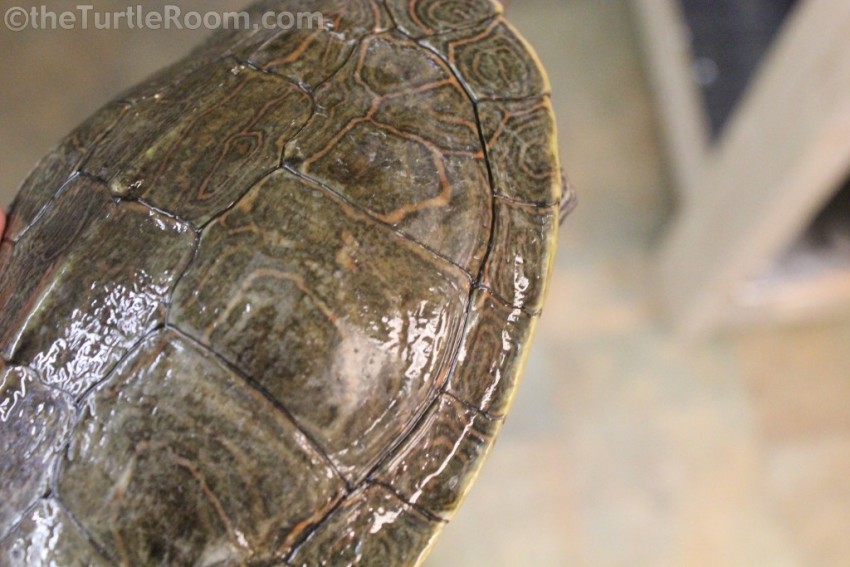
-

-
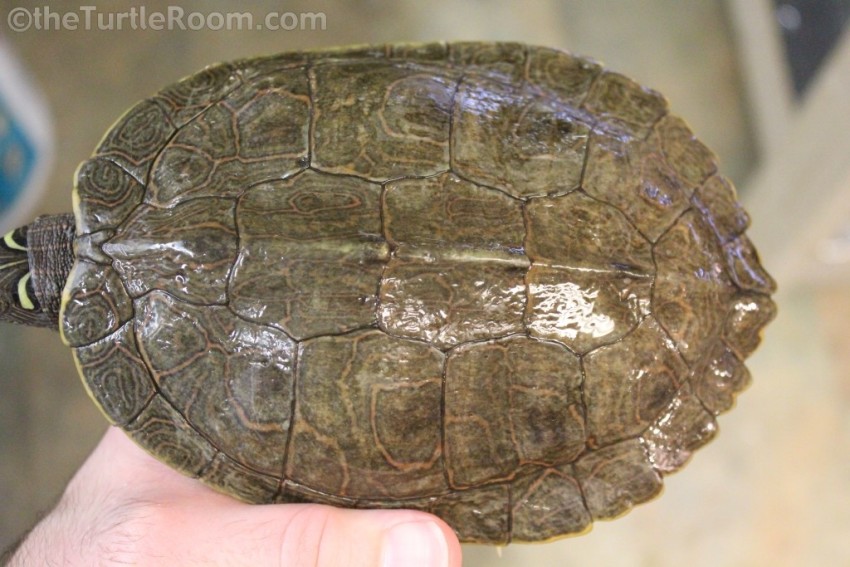
-

-

-
 Top of Head: Hockey-stick-shaped post-orbital markingsTop of Head: Hockey-stick-shaped post-orbital markings
Top of Head: Hockey-stick-shaped post-orbital markingsTop of Head: Hockey-stick-shaped post-orbital markings -
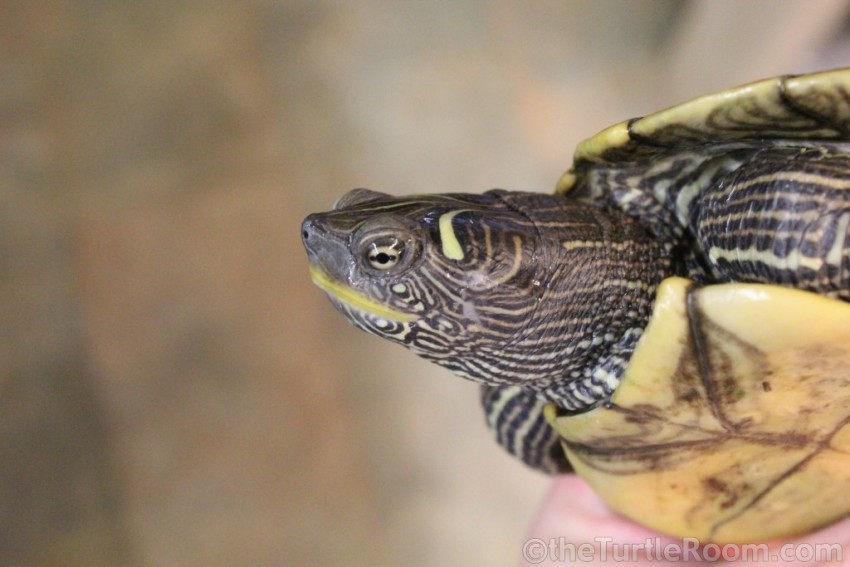
-
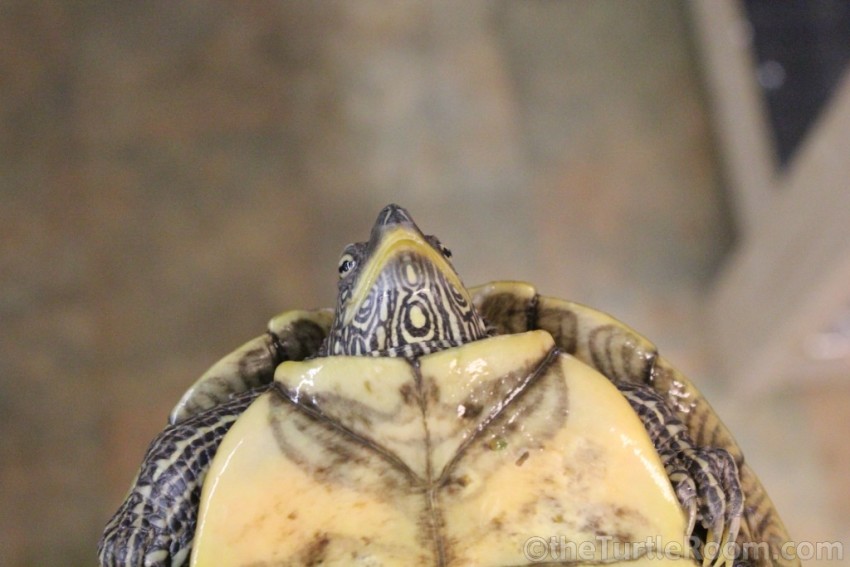
-
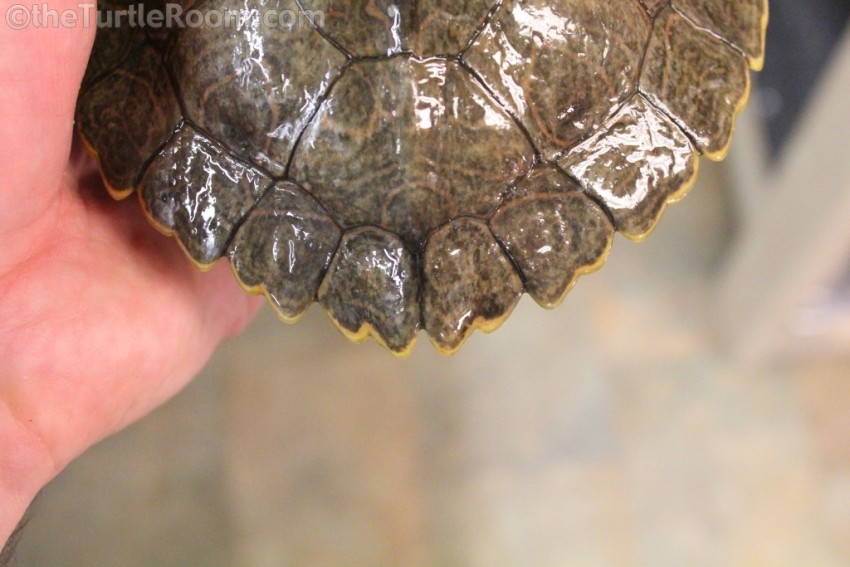
-
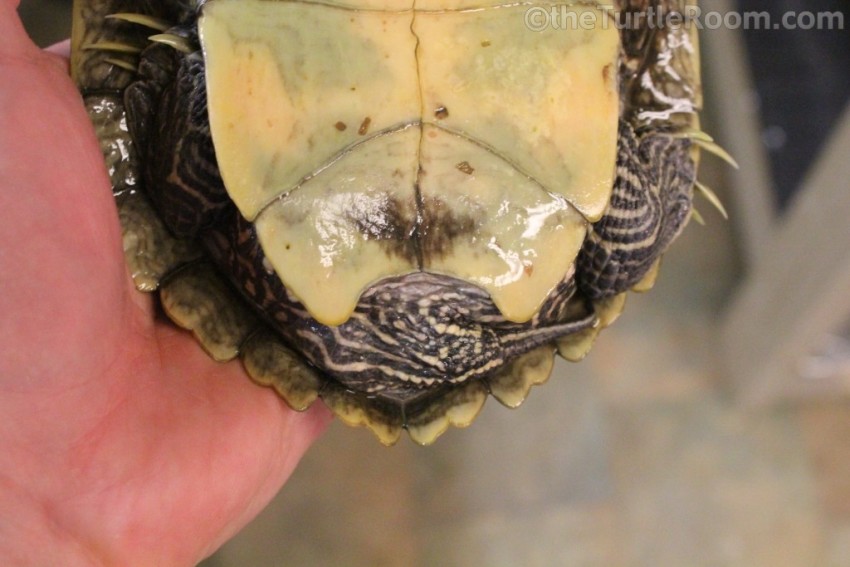
Distribution
The False Map Turtle has a wide distribution through the Mississippi drainage and several smaller drainages, mostly to the west. Records include observations through parts of Ohio, Indiana, Illinois, Wisconsin, Minnesota, North and South Dakota, western Kentucky, Tennessee, and Missouri. Due to its wide range, numerous river systems are inhabited by this species – the larger systems include the Mississippi, Missouri, and Ohio drainages.
Native Habitat
G. pseudogeographica ssp. primarily occupies medium-to-large rivers and their backwaters, but also uses floodplain habitats and impoundments (lakes and ponds). Plentiful aquatic vegetation seems to be a preference in habitat characteristics, as are slower currents and a multitude of basking locations. In Kansas and Wisconsin, this species was frequently found in areas with a muddy substrate. In Kentucky, there was a wide selection of habitats used by the False Map Turtle. Abundant mollusk prey has also been associated with well-populated habitats.
Wild Diet
The False Map turtle is generally omnivorous with diet staples changing based on the location of the turtle. Those in the Mississippi River feed mainly on terrestrial vegetation that has been submerged by high water, in the Illinois River, caddis fly larvae are the dietary staple, while females from a wide range of habitats feed on pondweed, duckweed, algae, mollusks, and mayfly nymphs. In Kentucky, adult females typically ate Asian clams, fish carrion, mayfly nymphs, and algae. Smaller females ate Asian clams, snails, algae, and bryozoan colonies. Meanwhile, the male diet included chironomid egg cases, algae, small Asian clams, and sponges. Juveniles feasted mainly on small snails, adult flies, and caddis fly larvae. A general list of prey species includes: freshwater sponges; bryozoans; clams; snails; crayfish; spiders; insects and their larvae; fish; algae; carrion; and assorted seeds, fruits, and leaves of plants.
Behavior
Due to G. ouachitensis ssp. having been previously listed under G. pseudogeographica, much of the behavioral history is partially masked between G. ouachitensis ssp. and G. pseudogeographica ssp. These species are active from late March to mid-October, with shorter active periods in the north and longer active periods in the south (sometimes year-round). They have a tendency to hibernate in groups. Winterkill has been documented during dry winters in some locations within the range. These species, including juveniles, spend a large portion of their day basking. Selected basking locations are seldom on or near shore and can be as high as 2 meters above the water surface. While basking, these species are wary and difficult to approach; one turtle re-entering the water due to disturbance often leads others to follow. Peak basking appears to occur in March – April, June, and September – November. Many different internal parasites have been reported. Predators of hatchlings include ring-billed gulls, American crows, grackles, and red-winged blackbirds. Adults have fewer predators, and a symbiotic relationship between grackles and turtles has been observed, as the turtles have allowed the grackles to approach and pull leeches from them.
Reproduction
Males are sexually mature at a minimum PL of approximately 3" (7.5cm), which they typically reach by the time they are 3-4 years old in the wild. Females mature at a PL around 7.1" (18cm), which may require as many as 8-12 years to reach. Captive specimens tend to grow and mature more quickly due to a nearly year-round growing season.
Courtship and mating occur in both spring (mainly April) and fall (October and November). A common courtship ritual is for the male to begin by placing his nostrils near the female’s anal vent, and possible even nip at her hind region. He then will position himself in front of the female, nearly touching her nose with his, then positions his forelegs with palms facing the female’s face and vibrates them against the side of her head. He may bob his head up and down in coordination with the claw fanning. This act is followed by the male swimming behind the female and if she remains motionless he will attempt to mount the female by hooking his tail around hers.
Nesting season runs from mid May through late July depending on location within their range. They will nest at any time of the day, but seem to have a preference between 6:30 and 10 in the morning. The False Map Turtle will typically lay 2 clutches per year, but occasionally 3 or 4. Clutch size varies from 8-22 eggs, with an average of 10-14, depending on the locale. G. pseudogeographica ssp. has TSD-1a, meaning males come from lower temperatures and females from higher temperatures. The pivotal temperature is approximately 84°F (29°C) with 100% males at 77°F (25°C) and 100% females at 86°F (30°C).
This Care Guide is an external Care Guide. While it is possible this care guide may not be for the exact species you were looking for, it provides information suitable for your species. This Care Guide link will take you away from theTurtleRoom. We only link to care guides we trust. Thanks for visiting theTurtleRoom.org.
Care GuideIf you would like to contribute to the photo gallery of any turtle or tortoise species, please email us at [email protected]. You will be credited for any photos you contribute.
| Graptemys pseudogeographica pseudogeographica |
| (Gray, 1831) |
| IUCN Red List: |
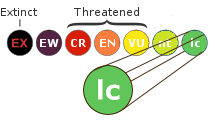 |
| Least Concern (2011) |
| Order: | Testudines |
| Suborder: | Cryptodira |
| Superfamily: | Testudinoidea |
| Family: | Emydidae |
| Subfamily: | Deirochelyinae |
| Genus: | Graptemys |
| species: | pseudogeographica |
| subspecies: | pseudogeographica |
| CITES: | Appendix III |
Author:
Editors: Stephen J. Enders, Anthony Pierlioni, Chris Leone, Andrew S. Weber, Ben Forrest, and Andrew Hermes
Sources
Disclaimer: The Species Profiles - Natural History, Care Guide, and Photo Gallery database is an educational resource. It does not cover all Chelonian species in the world, nor does it include all the latest scientific information about the species covered. Though we edit our accounts for accuracy, we cannot guarantee all information in those accounts. While theTurtleRoom's staff and contributors provide references to books and websites that we believe are reputable, we cannot necessarily endorse the contents of references beyond our control.

This work by theTurtleRoom is licensed under a Creative Commons Attribution-NonCommercial-ShareAlike 4.0 International License.






























